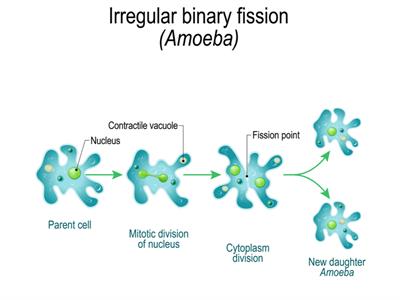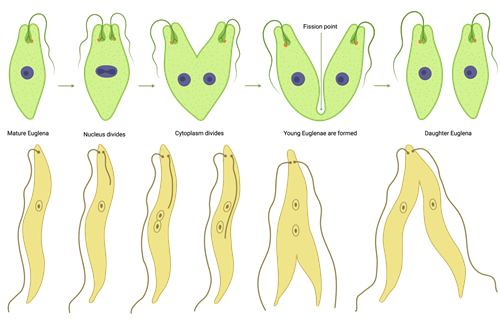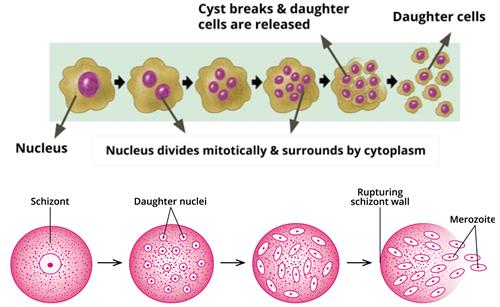
PUMPA - SMART LEARNING
எங்கள் ஆசிரியர்களுடன் 1-ஆன்-1 ஆலோசனை நேரத்தைப் பெறுங்கள். டாப்பர் ஆவதற்கு நாங்கள் பயிற்சி அளிப்போம்
Book Free DemoIn this theory, we will look into various modes of asexual reproduction.
Fission:
In unicellular organisms, fission leads to the production of new individuals. In this mode of reproduction, the parent cell divides into two or more daughter cells, and each cell develops into a new adult organism. Here, the process of reproduction can occur through binary or multiple fission.
1. Binary fission:
Binary fission involves the process of mitosis, where the daughter cells are genetically identical to the parent. Fission occurs in a variety of patterns. Depending upon the plane of division, binary fission is of different types:
a. Simple binary fission:
Different bacteria and protozoa split into two halves during cell division. In organisms such as Amoeba, the splitting of two cells during division can occur in any plane.

Binary fission in Amoeba
b. Longitudinal binary fission:
The division of the organism is along the longitudinal axis of the organism. It takes place in Leishmania (which cause kala-azar) and Euglena. Here, the flagellum divides first, followed by the body.

Longitudinal binary fission in Euglena and Leishmania
c. Transverse binary fission:
The division of the organism is along the transverse axis of the individual.
Example:
Planaria, Paramecium, Diatoms and Bacteria.

Transverse binary fission in Paramecium
2. Multiple fission:
In multiple fission, the parent body divides into many similar daughter cells simultaneously.
In Plasmodium, the malarial parasite divides into many daughter cells through multiple fission. Multiple fission occurs in the schizont through the process called schizogony, and the daughter cells are called merozoites.

Multiple fission in Amoeba and Plasmodium
In Amoeba, under unfavourable conditions, it secretes a thick covering called a cyst wall around itself. When the favourable condition returns, Amoeba divides by multiple fission and produces multiple amoebae.
A video explaining the types of fission: